Abstract
Uroporphyrinogen decarboxylase activity was measured in liver and erythrocytes of normal subjects and in patients with porphyria cutanea tarda and their relatives. In patients with porphyria cutanea tarda, hepatic uroporphyrinogen decarboxylase activity was significantly reduced (mean 0.43 U/mg protein; range 0.25-0.99) as compared to normal subjects (mean 1.61 U/mg protein; range 1.27-2.42). Erythrocyte uroporphyrinogen decarboxylase was also decreased in patients with porphyria cutanea tarda. The mean erythrocyte enzymatic activity in male patients was 0.23 U/mg Hb (range 0.16-0.30) and in female patients was 0.17 U/mg Hb (range 0.15-0.18) as compared with mean values in normal subjects of 0.38 U/mg Hb (range 0.33-0.45) in men and 0.26 U/mg Hb (range 0.18-0.36) in women. With the erythrocyte assay, multiple examples of decreased uroporphyrinogen decarboxylase activity were detected in members of three families of patients with porphyria cutanea tarda. In two of these families subclinical porphyria was also recognized. The inheritance pattern was consistant with an autosomal dominant trait. The difference in erythrocyte enzymatic activity between men and women was not explained but could have been due to estrogens. This possibility was supported by the observation that men under therapy with estrogens for carcinoma of the prostate had values in the normal female range. It is proposed that porphyria cutanea tarda results from the combination of an inherited defect in uroporphyrinogen decarboxylase and an acquired factor, usually siderosis associated with alcoholic liver disease.
Full text
PDF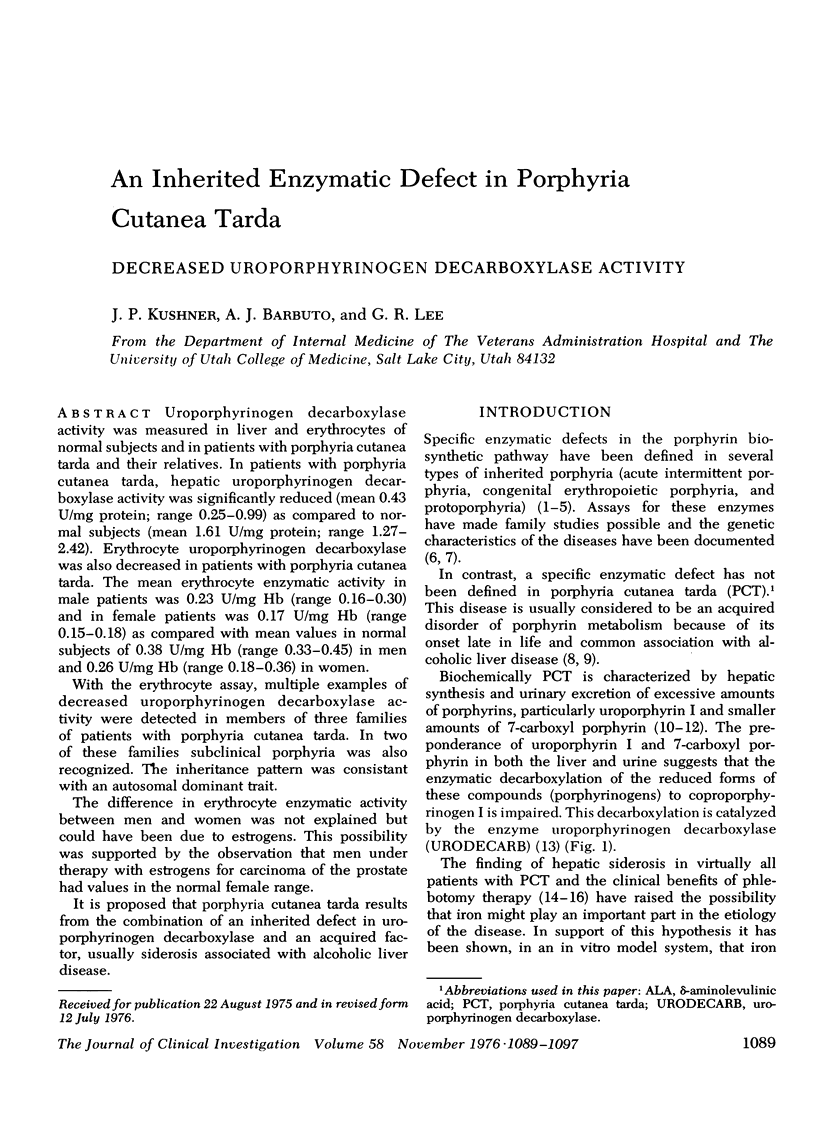
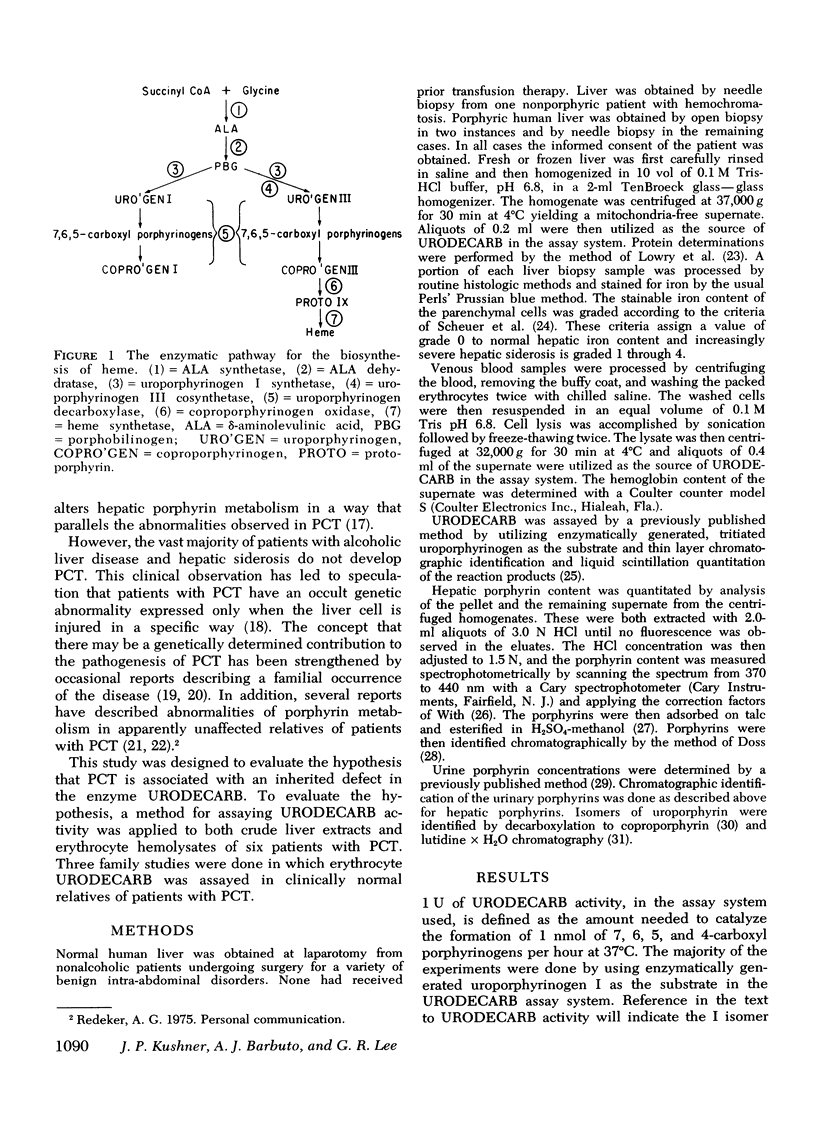
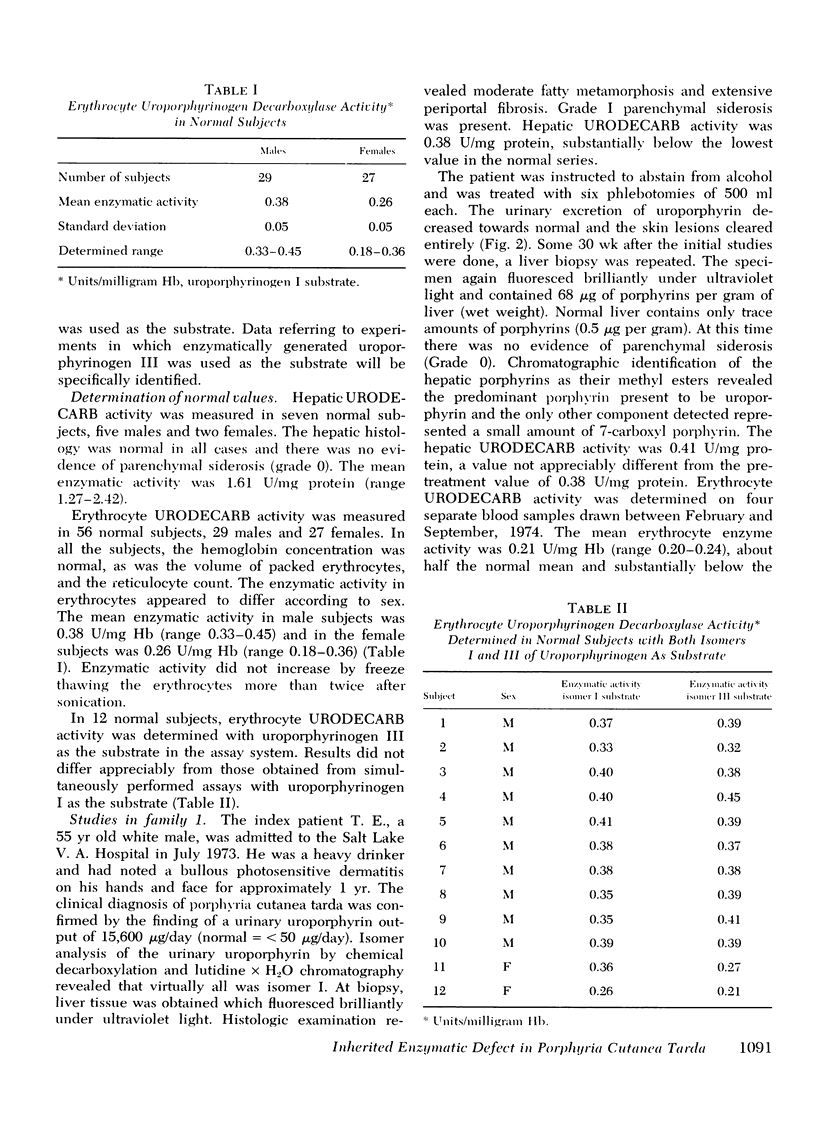
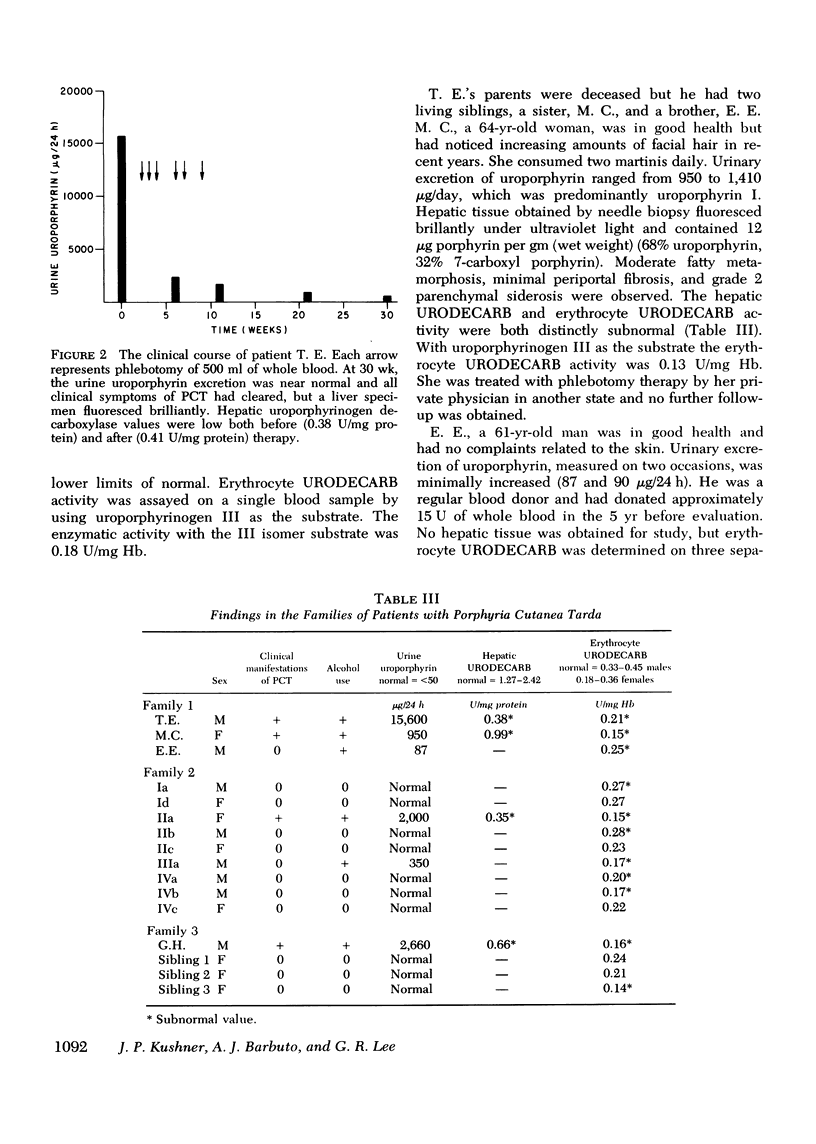
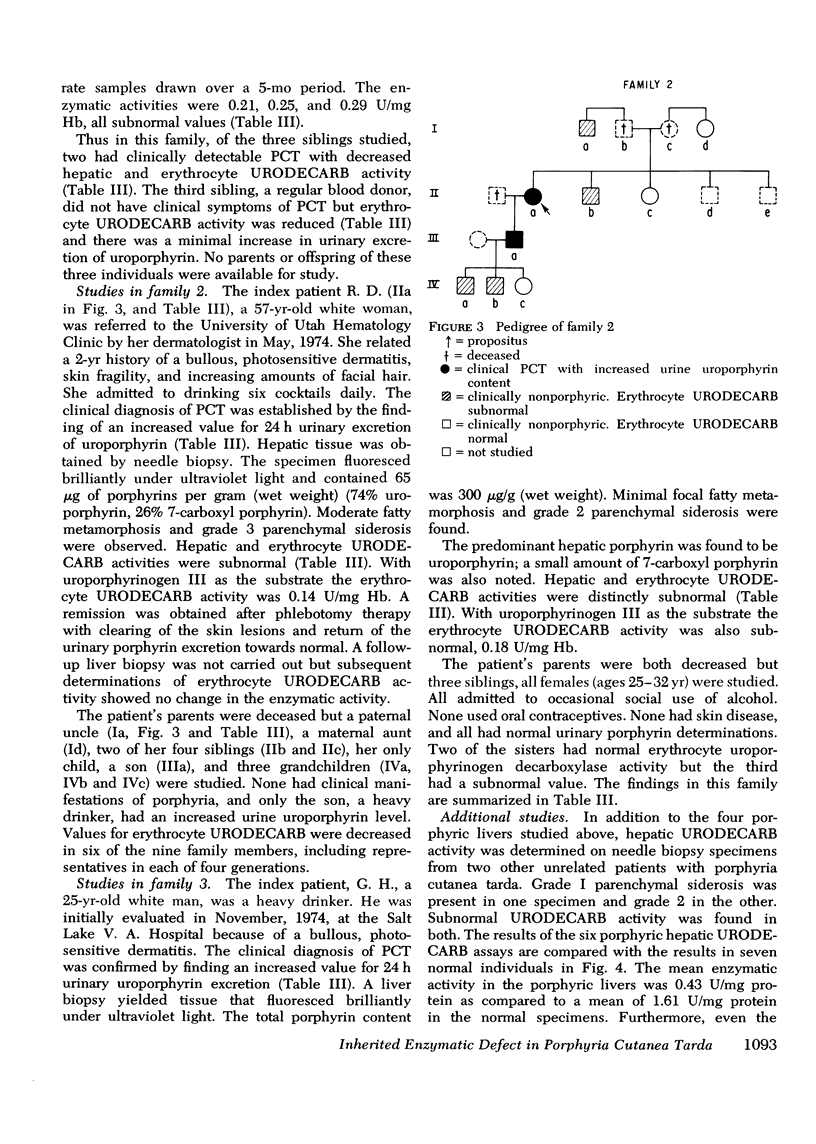
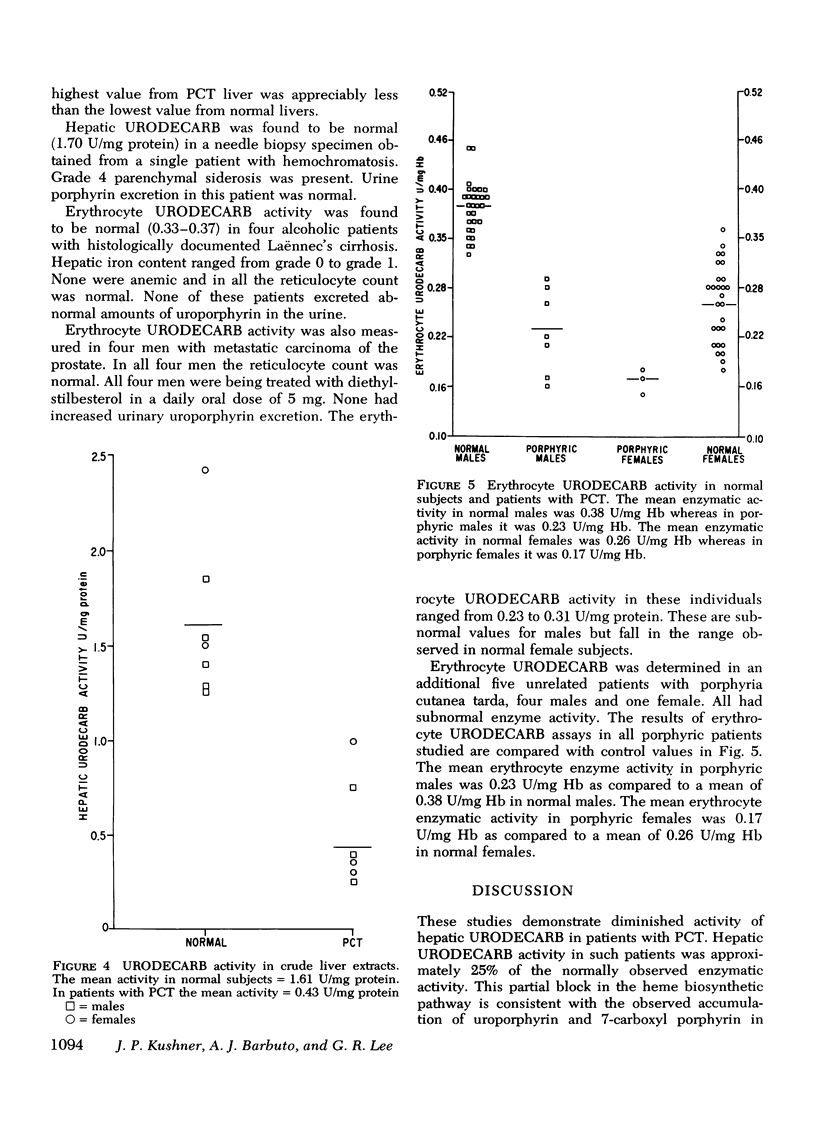
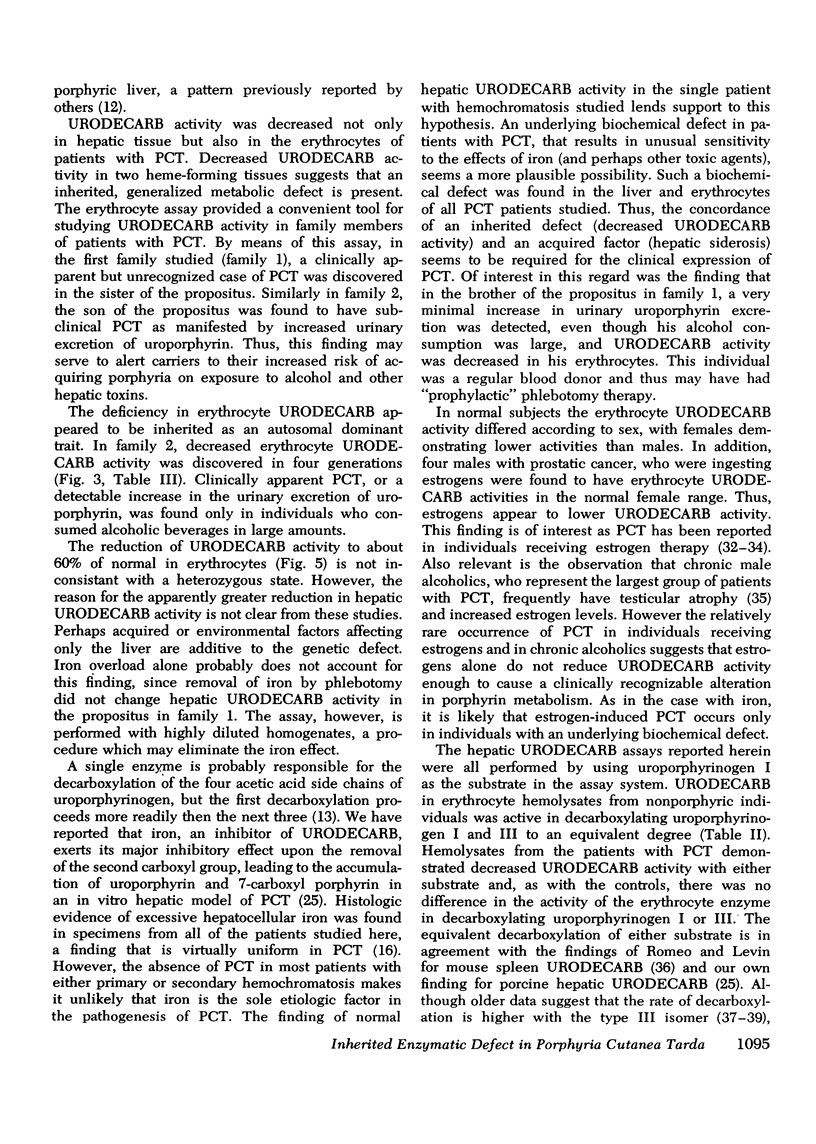
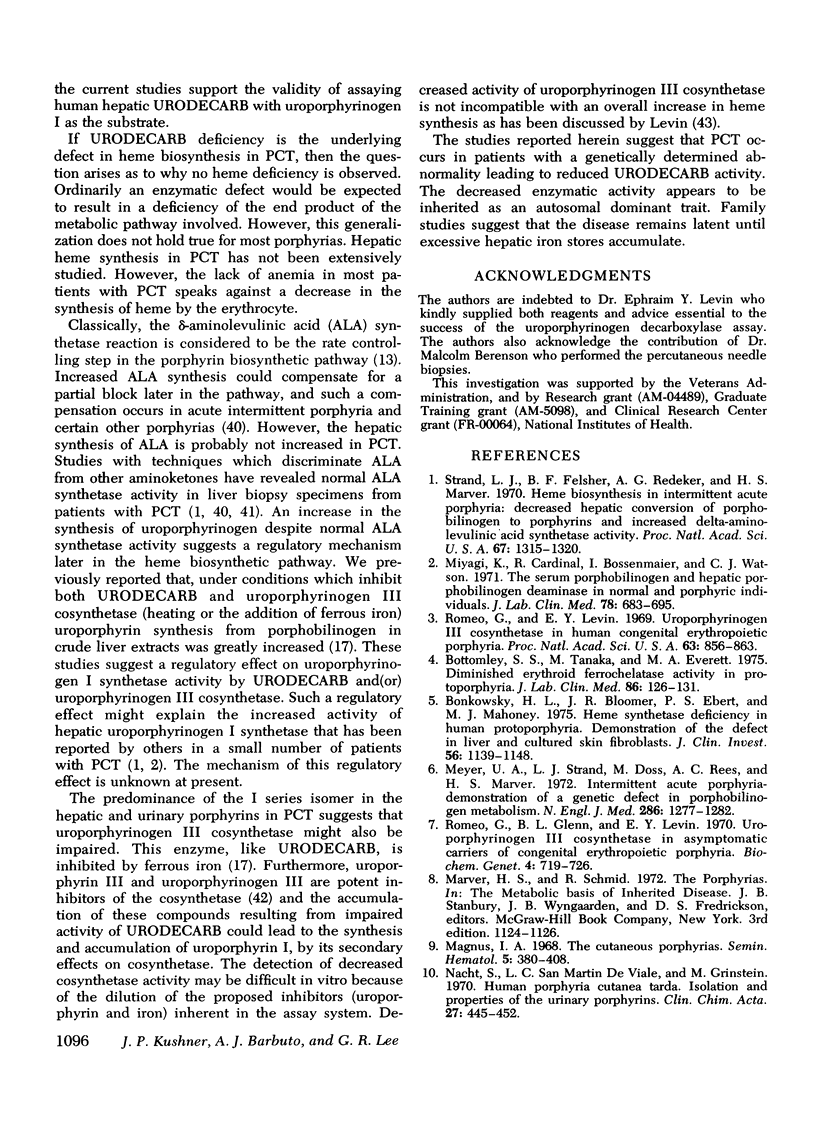
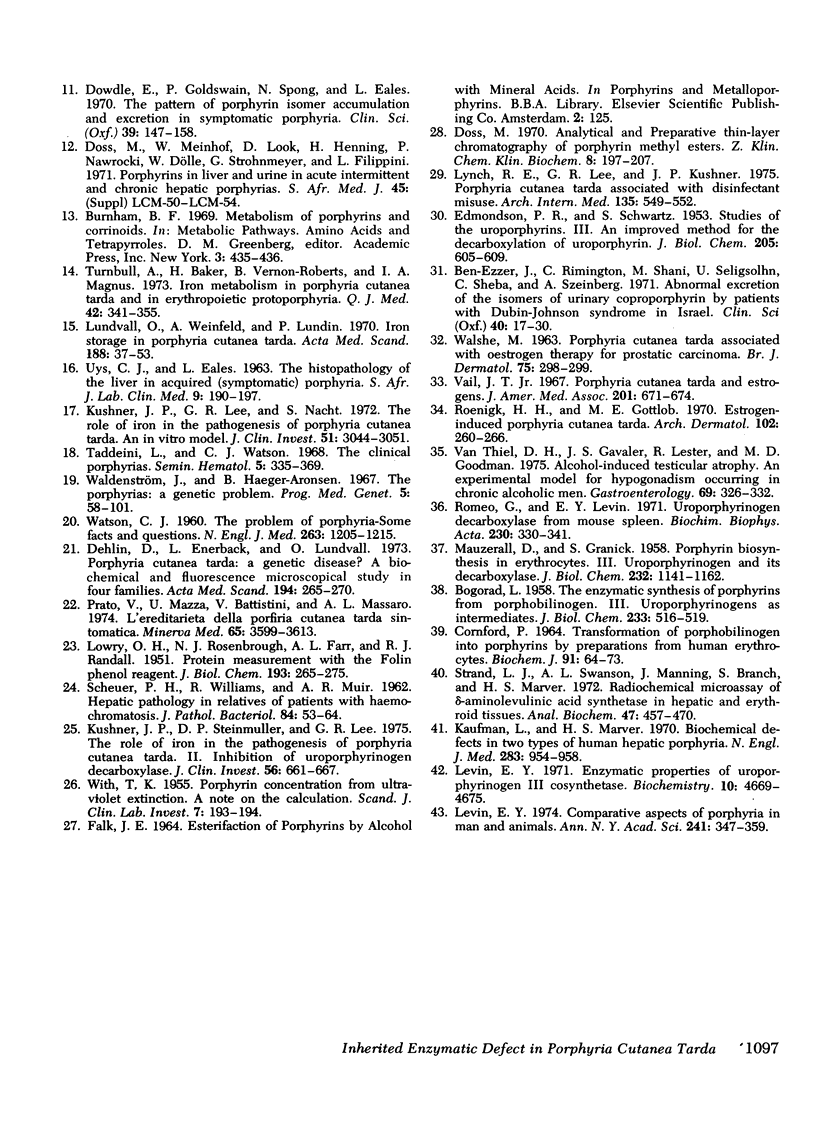
Selected References
These references are in PubMed. This may not be the complete list of references from this article.
- BOGORAD L. The enzymatic synthesis of porphyrins from porphobilinogen. III. Uroporphyrinogens as intermediates. J Biol Chem. 1958 Aug;233(2):516–519. [PubMed] [Google Scholar]
- Ben-Ezzer J., Rimington C., Shani M., Seligsohn U., Sheba C., Szeinberg A. Abnormal excretion of the isomers of urinary coproporphyrin by patients with Dubin-Johnson syndrome in Israel. Clin Sci. 1971 Jan;40(1):17–30. doi: 10.1042/cs0400017. [DOI] [PubMed] [Google Scholar]
- Bonkowsky H. L., Bloomer J. R., Ebert P. S., Mahoney M. J. Heme synthetase deficiency in human protoporphyria. Demonstration of the defect in liver and cultured skin fibroblasts. J Clin Invest. 1975 Nov;56(5):1139–1148. doi: 10.1172/JCI108189. [DOI] [PMC free article] [PubMed] [Google Scholar]
- Bottomley S. S., Tanaka M., Everett M. A. Diminished erythroid ferrochelatase activity in protoporphyria. J Lab Clin Med. 1975 Jul;86(1):126–131. [PubMed] [Google Scholar]
- Cornford P. Transformation of porphobilinogen into porphyrins by preparations from human erythrocytes. Biochem J. 1964 Apr;91(1):64–73. doi: 10.1042/bj0910064. [DOI] [PMC free article] [PubMed] [Google Scholar]
- Dehlin O., Enerbäck L., Lundvall O. Porphyria cutanea tarda-a genetic disease? A biochemical and fluorescence microscopical study in four families. Acta Med Scand. 1973 Oct;194(4):265–270. [PubMed] [Google Scholar]
- Doss M. Analytical and preparative thin-layer chromatography of porphyrin methyl esters. Z Klin Chem Klin Biochem. 1970 May;8(3):197–207. doi: 10.1515/cclm.1970.8.3.197. [DOI] [PubMed] [Google Scholar]
- Dowdle E., Goldswain P., Spong N., Eales L. The pattern of porphyrin isomer accumulation and excretion in symptomatic porphyria. Clin Sci. 1970 Aug;39(2):147–158. doi: 10.1042/cs0390147. [DOI] [PubMed] [Google Scholar]
- EDMONDSON P. R., SCHWARTZ S. Studies of the uroporphyrins. III. An improved method for the decarboxylation of uroporphyrin. J Biol Chem. 1953 Dec;205(2):605–609. [PubMed] [Google Scholar]
- Kaufman L., Marver H. S. Biochemical defects in two types of human hepatic porphyria. N Engl J Med. 1970 Oct 29;283(18):954–958. doi: 10.1056/NEJM197010292831803. [DOI] [PubMed] [Google Scholar]
- Kushner J. P., Lee G. R., Nacht S. The role of iron in the pathogenesis of porphyria cutanea tarda. An in vitro model. J Clin Invest. 1972 Dec;51(12):3044–3051. doi: 10.1172/JCI107131. [DOI] [PMC free article] [PubMed] [Google Scholar]
- Kushner J. P., Steinmuller D. P., Lee G. R. The role of iron in the pathogenesis of porphyria cutanea tarda. II. Inhibition of uroporphyrinogen decarboxylase. J Clin Invest. 1975 Sep;56(3):661–667. doi: 10.1172/JCI108136. [DOI] [PMC free article] [PubMed] [Google Scholar]
- LOWRY O. H., ROSEBROUGH N. J., FARR A. L., RANDALL R. J. Protein measurement with the Folin phenol reagent. J Biol Chem. 1951 Nov;193(1):265–275. [PubMed] [Google Scholar]
- Levin E. Y. Comparative aspects of porphyria in man and animals. Ann N Y Acad Sci. 1974 Nov 29;241(0):347–359. doi: 10.1111/j.1749-6632.1974.tb21892.x. [DOI] [PubMed] [Google Scholar]
- Levin E. Y. Enzymatic properties of uroporphyrinogen 3 cosynthetase. Biochemistry. 1971 Dec 7;10(25):4669–4675. doi: 10.1021/bi00801a012. [DOI] [PubMed] [Google Scholar]
- Lundvall O., Weinfeld A., Lundin P. Iron storage in porphyria cutanea tarda. Acta Med Scand. 1970 Jul-Aug;1-2(1):37–53. doi: 10.1111/j.0954-6820.1970.tb08003.x. [DOI] [PubMed] [Google Scholar]
- Lynch R. E., Lee G. R., Kushner J. P. Porphyria cutanea tarda associated with disinfectant misuse. Arch Intern Med. 1975 Apr;135(4):549–552. [PubMed] [Google Scholar]
- MAUZERALL D., GRANICK S. Porphyrin biosynthesis in erythrocytes. III. Uroporphyrinogen and its decarboxylase. J Biol Chem. 1958 Jun;232(2):1141–1162. [PubMed] [Google Scholar]
- Magnus I. A. The cutaneous porphyrias. Semin Hematol. 1968 Oct;5(4):380–408. [PubMed] [Google Scholar]
- Meyer U. A., Strand L. J., Doss M., Rees A. C., Marver H. S. Intermittent acute porphyria--demonstration of a genetic defect in porphobilinogen metabolism. N Engl J Med. 1972 Jun 15;286(24):1277–1282. doi: 10.1056/NEJM197206152862401. [DOI] [PubMed] [Google Scholar]
- Miyagi K., Cardinal R., Bossenmaier I., Watson C. J. The serum porphobilinogen and hepatic porphobilinogen deaminase in normal and porphyric individuals. J Lab Clin Med. 1971 Nov;78(5):683–695. [PubMed] [Google Scholar]
- Nacht S., San Martín de Viale L. C., Grinstein M. Human porphyria cutanea tarda. Isolation and properties of the urinary porphyrins. Clin Chim Acta. 1970 Mar;27(3):445–452. doi: 10.1016/0009-8981(70)90297-4. [DOI] [PubMed] [Google Scholar]
- Prato V., Mazza U., Battistini V., Massaro A. L. L'ereditarietà della porfiria cutanea tarda sintomatica. Minerva Med. 1974 Oct 3;65(69):3599–3613. [PubMed] [Google Scholar]
- Roenigk H. H., Jr, Gottlob M. E. Estrogen-induced porphyria cutanea tarda. Report of three cases. Arch Dermatol. 1970 Sep;102(3):260–266. [PubMed] [Google Scholar]
- Romeo G., Glenn B. L., Levin E. Y. Uroporphyrinogen 3 cosynthetase in asymptomatic carriers of congenital erythpoietic porphyria. Biochem Genet. 1970 Dec;4(6):719–726. doi: 10.1007/BF00486385. [DOI] [PubMed] [Google Scholar]
- Romeo G., Levin E. Y. Uroporphyrinogen 3 cosynthetase in human congenital erythropoietic porphyria. Proc Natl Acad Sci U S A. 1969 Jul;63(3):856–863. doi: 10.1073/pnas.63.3.856. [DOI] [PMC free article] [PubMed] [Google Scholar]
- Romeo G., Levin E. Y. Uroporphyrinogen decarboxylase from mouse spleen. Biochim Biophys Acta. 1971 Feb 23;230(2):330–341. doi: 10.1016/0304-4165(71)90220-0. [DOI] [PubMed] [Google Scholar]
- SCHEUER P. J., WILLIAMS R., MUIR A. R. Hepatic pathology in relatives of patients with haemochromatosis. J Pathol Bacteriol. 1962 Jul;84:53–64. [PubMed] [Google Scholar]
- Strand L. J., Felsher B. F., Redeker A. G., Marver H. S. Heme biosynthesis in intermittent acute prophyria: decreased hepatic conversion of porphobilinogen to porphyrins and increased delta aminolevulinic acid synthetase activity. Proc Natl Acad Sci U S A. 1970 Nov;67(3):1315–1320. doi: 10.1073/pnas.67.3.1315. [DOI] [PMC free article] [PubMed] [Google Scholar]
- Strand L. J., Swanson A. L., Manning J., Branch S., Marver H. S. Radiochemical microassay of delta-aminolevulinic acid synthetase in hepatic and erythroid tissues. Anal Biochem. 1972 Jun;47(2):457–470. doi: 10.1016/0003-2697(72)90139-x. [DOI] [PubMed] [Google Scholar]
- Taddeini L., Watson C. J. The clinical porphyrias. Semin Hematol. 1968 Oct;5(4):335–369. [PubMed] [Google Scholar]
- Turnbull A., Baker H., Vernon-Roberts B., Magnus I. A. Iron metabolism in porphyria cutanea tarda and in erythropoietic protoporphyria. Q J Med. 1973 Apr;42(166):341–355. [PubMed] [Google Scholar]
- UYS C. J., EALES L. THE HISTOPATHOLOGY OF THE LIVER IN ACQUIRED (SYMPTOMATIC) PORPHYRIA. S Afr J Lab Clin Med. 1963 Dec;14:190–197. [PubMed] [Google Scholar]
- Vail J. T., Jr Porphyria cutanea tarda and estrogens. JAMA. 1967 Aug 28;201(9):671–674. [PubMed] [Google Scholar]
- Van Thiel D. H., Gavaler J. S., Lester R., Goodman M. D. Alcohol-induced testicular atrophy. An experimental model for hypogonadism occurring in chronic alcoholic men. Gastroenterology. 1975 Aug;69(2):326–332. [PubMed] [Google Scholar]
- WARIN R. P. PORPHYRIA CUTANEA TARDA ASSOCIATED WITH OESTROGEN THERAPY FOR PROSTATIC CARCINOMA. Br J Dermatol. 1963 Jul;75:298–299. [PubMed] [Google Scholar]
- WATSON C. J. The problem of porphyria--some facts and questions. N Engl J Med. 1960 Dec 15;263:1205–1215. doi: 10.1056/NEJM196012152632401. [DOI] [PubMed] [Google Scholar]
- Waldenström J., Haeger-Aronsen B. The porphyrias: a genetic problem. Prog Med Genet. 1967;5:58–101. doi: 10.1016/b978-1-4831-6757-2.50006-3. [DOI] [PubMed] [Google Scholar]


